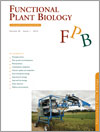
Functional Plant Biology
Volume 40 Number 1 2013
FP12180A multisite managed environment facility for targeted trait and germplasm phenotyping
Numerous traits, genes and quantitative trait loci have been proposed for improving performance based on glasshouse studies but few have been used in variety development. A series of managed environment facilities have been developed to allow careful field validation of germplasm under controlled water and heat stress. Lines are benchmarked against elite commercial lines and varieties to demonstrate trait value and facilitate uptake of the traits into breeding programs.
FP12184Genomic regions for canopy temperature and their genetic association with stomatal conductance and grain yield in wheat
This manuscript confirms the genetic association of canopy temperature and stomatal conductance in wheat. However, the nature of this relationship varies with factors affecting canopy architecture, thereby reducing confidence for use in breeding high yielding wheat varieties. Knowledge of boundary layer influence on canopy temperature contributed to development of statistical-genetic models to increase confidence in selection of wheat breeding lines with altered stomatal conductance and higher yield potential.
FP12164After initial invigoration by heading, young pear trees show reduction in axis vigour and increased propensity to flower
Fast establishment of the canopy in young fruit trees quickly followed by reduced growth and precocity are desirable traits in fruit production. We found that severe heading (cutting back the trunk of the tree after the first year of growth) helps to achieve these traits in pear trees. These results will be used for guiding the best approaches to improving productivity of young pear trees.
FP12181Water extraction under terminal drought explains the genotypic differences in yield, not the anti-oxidant changes in leaves of pearl millet (Pennisetum glaucum)
Research on the anti-oxidant enzymes reports their key role for drought tolerance of crops, but this research has neglected the importance of plant/soil water status. Anti-oxidative enzymes activities varied under drought in pearl millet, did not relate to higher grain yield, but related to higher water extraction during grain filling, which was indeed the driving cause for higher grain yield. Results show the importance of a water-based framework to undertake drought research.
FP12163Water extraction and root traits in Oryza sativa × Oryza glaberrima introgression lines under different soil moisture regimes
The African rice species Oryza glaberrima Steud. may be a valuable source of stress tolerance genes. Of the 200 Oryza sativa L. × O. glaberrima progeny screened in a greenhouse lysimeter facility, several were identified for further study of root growth and water uptake under drought. These lines will next be evaluated in the target environment to confirm their potential as drought tolerance donors.
FP12234Mutational loss of Arabidopsis SLOW WALKER2 results in reduced endogenous spermine concomitant with increased aluminum sensitivity
Aluminum toxicity is a severe limitation to global agriculture, with plants having developed various mechanisms to either exclude or tolerate Al in their environment. In this report, we demonstrate that endogenous polyamines are required for plants to grow in an Al toxic environment since polyamines likely compete with Al3+ for binding at anionic sites within the root. Increased levels of polyamines may be an approach for engineering Al resistance in plants.
FP12194The effect of aerobic soil conditions, soil volume and sowing date on the development of four tropical rice varieties grown in the greenhouse
Aerobic rice suffers a yield penalty in comparison with flooded rice even when water in the soil is abundant. We show that aerobic soil conditions slow down the rate of leaf development and consequently delay heading time in a controlled environment. This reaction is an additional link to the chain of consequences that leads to yield reduction in such an environment.
FP12158Copper in xylem and phloem saps from rice (Oryza sativa): the effect of moderate copper concentrations in the growth medium on the accumulation of five essential metals and a speciation analysis of copper-containing compounds
Copper (Cu) is a toxic metal but also an essential element for the growth and yield of cereal plants such as rice. The results of experiments with rice seedlings indicate that Cu absorbed by roots is delivered to the shoots via the xylem and phloem in chelate-bound forms. Although free Cu ions are highly toxic for plants, chelate-bound Cu can be delivered as an essential nutrient without inducing toxicity.




